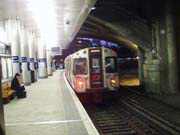It’s official: PATH, bridge and tunnel fares will be going up. Among those who commute, there seemed to be more acceptance than anger last week.
“About fifty cents more isn’t too bad,” said John McConnell, who drives from North Plainfield to Journal Square and takes the PATH to 23rd St. “Two dollars [would have been] too much.”
The Port Authority of New York and New Jersey had initially proposed raising fares on PATH from $1 to $2 per trip and bridge and tunnel cash fares from $4 to $7. Officials at Port Authority acknowledged that the hikes were a “worst case scenario,” and many anticipated that the numbers would come down.
After public outcry at hearings across the state last month, Port Authority officials said they would reconsider the rates.
They did, as outgoing Gov. Christine Todd Whitman signed off on a plan that will raise one-way PATH trips to $1.50. Frequent-trip cards, however, will bring the average price down. An 11-trip card would cost $15, an average cost of $1.36 per trip. Twenty trips would cost $24, for a $1.20 average. Forty trips would cost $48, for a $1.20 average. Senior fares will cost $1.
On the Lincoln and Holland Tunnel, cash fares will spike from $4 to $6 at all times. With E-Z Pass, fares will go down. For peak-hours (weekdays, 6 to 9 a.m. and 4 to 7 p.m., weekends noon to 8 p.m.), the E-Z pass will cost $5. All other “off-peak” times will run $4.
The hikes will take affect at 3 a.m. on March 25.
Port Authority had argued that the new fares, part of a five-year $13 billion capital improvement plan, would serve to lessen traffic at bridges and tunnels at peak hours. In the case of PATH, the agency stated that money would go to buy newer, longer cars and fix an antiquated signaling system.
Different opinions
Two people interviewed last week were unaware of the impending hike.
“I didn’t know,” said Hina Patel, a Long Island University Student who was picking up a train at Journal Square last week. When told a single trip would go up from $1 to $1.50, she responded, “It’s a lot.”
She had an excuse for not knowing. It was her first day taking the train.
Those in the know, like Shirley Spriggs of Jersey City, an employee for the New Jersey Benefits Fund in Newark, had a definite opinion.
“I think it’s lousy,” she said of the hike. Then she spoke of the train conditions. “It’s too crowded. You should see it at Pavonia.” She demonstrated her techniques of elbowing her way onto a car.
Nevertheless, she won’t stop using the train.
“I’ll be ready for it,” she said of the increase, with a hint of resignation. “You can’t stop progress.”
A woman named Olga, who did not want her last name used, takes the train from to the World Trade Center every day.
“It’s my only way to commute in and out of Manhattan,” she said. She said she will continue to take the train, and she compared the increase with taxes.
There’s very little, she pointed out, that one person can do to stop them from rising.
No static at all …
OK, so you’ll have to shell out two more bucks for the Lincoln and Holland tunnels. You’re not too thrilled with that. On the plus side, as you stew with fellow commuters under those fluorescent tube lights, you won’t have to abandon Howard Stern, J.M. in the A.M., or your favorite soft rock hits in search of fuzzy AM.
That’s because Port Authority of New York and New Jersey has installed radio equipment inside the tunnel ventilation buildings to receive FM signals. The signals are piped to antennas mounted on the walls inside the tunnel and then into your car.
“It is our goal to make our customers’ trips as pleasant as possible,” said Ken Philmus, the Port Authority’s Director of Tunnels, Bridges and Terminals. “Through the use of new technology, we will ensure that FM music doesn’t go silent in our tunnels.”
The new system will also allow the Port Authority to override FM and AM radio signals to provide customers with traffic an operational information.
